Top Dressing Lawn with Compost: When, How + Benefits
Top-dressing is the application of a light layer of organic material across a lawn. The organic material boosts plant growth and health while also improving soil quality. Common topdressing materials include compost, peat moss, sand, and topsoil.
Topdressing a lawn with compost boosts the water holding capacity of soil and makes grass grow thicker and richer in color. Use compost spreaders or the shovel-and-rake method to top-dress your lawn during spring for warm-season grasses and early spring or late fall for cold-season grasses.
Is compost good for grass?
Compost is good for grass as it encourages deeper rooting, making grass turfs more drought-hardy. A turf that’s been top-dressed with compost is also laden with essential nutrients that make the grass healthier and more resistant to pests.
Compost is not only good for grass but also better than several other alternatives to it. For instance, compost is an all-natural and eco-friendly fertilizer, unlike chemical fertilizers, which are toxic to the environment.
How to top dress a lawn with compost

You top dress your lawn by spreading the compost by hand or using various tools; rolling peat moss spreader, drop spreader, and tractor attachment spreader. However, before top-dressing your turf grass with compost, relieve lawn soil compaction, while considering the size of the compost particles.
Here’s how to top dress a lawn with compost:
1. Use a foot press machine to core-aerate your lawn
Core aeration is a crucial preliminary step that decreases compaction and lets oxygen and water get to your lawn. You can core-aerate your compact turfgrass using various tools, most notably, a foot press machine.
2. Ensure compost particles are not larger than ⅜” in size.
Compost particles should be no more than 3/8” in size. The best compost for top-dressing is screened compost, as the particles are small enough to easily pass through the grass blades. Also, ensure that your compost doesn’t include plant seeds, as this may lead to a weed problem on your lawn down the line.
Note: Compost particles that are too large will sit on top of your grass blades and smother the grass.
3. Top dress compost using hands or compost spreaders.
You can choose the manual shovel and rake method or compost spreaders to top-dress compost over your lawn. Your choice will be based on the effort you are willing to put in and the size of your lawn.
Here are different methods to apply compost over your lawn:
Fetch compost with a shovel and spread it with a leaf rake
You can top-dress your compost by hand using a shovel to fetch compost out of a wheelbarrow and disperse it over the entire turf. This is followed by even spreading using a leaf rake.
Note: Spreading compost material unevenly causes some sections of the turf to appear healthier/greener than others. The non-uniformity diminishes the lawn’s visual appeal.
Use a rolling peat moss spreader
A rolling peat moss spreader is an effective way to apply compost on your lawn since it requires minimal effort compared to the shovel and rake methods. Though traditionally used to spread peat moss, this tool can also be effectively used to spread compost over a lawn.
After filling the rotating barrel of your peat moss spreader, simply roll it over the entire turf area. The machine’s mesh openings allow compost particles to be released onto the lawn as you roll it along.
Note: Rolling peat moss spreaders work best when using screened compost because if some of the compost particles are too big, they’ll not be able to pass through the roller’s mesh openings.
Use a drop spreader
A drop spreader has an advantage over a peat moss spreader in that you can adjust the size of the openings. As such, you don’t have to use finely screened compost.
To use a drop spreader, fill its hopper with compost and open up the drop holes. Then, push the machine up and down the lawn until you cover the entire turf. To avoid clogging the spreader openings, don’t use this tool if the compost is still wet.
Use a broadcast spreader
Broadcast spreaders do a better job at dispersing than the other tools discussed here, as they work by tossing the compost rather than dropping it directly underneath the machine. However, if you’re going to use this tool, make sure the compost is dry and fine-screened as it’s highly susceptible to clogging.
Use a tractor attachment spreader
For huge lawns, tractor attachment spreaders are the best and fastest option. Featuring massive hoppers that carry and release large loads of compost at a time, these tools are designed to be attached to (and towed behind) lawn tractors.
4. Spray water after top-dressing
You should hydrate your lawn right after top-dressing it with compost, as water helps to spread the compost particles evenly throughout the turf and deeper into the soil. When spraying water after top-dressing, set the sprayer’s nozzle to the lowest setting to avoid washing away the compost material.
Benefits of spreading compost on your lawn
The benefits of spreading compost on your lawn include nutrient availability, dethatching, soil aeration, and improved moisture-holding capacity. Compost also boosts turf resistance to drought and is an eco-friendly fertilizer option.
Here are the advantages of spreading compost on your lawn:
1. Feeds the turf with essential nutrients
Compost matter contains several essential nutrients that grass plants need to thrive and survive including nitrogen, phosphorus, and potassium. It also contains micronutrients and trace minerals like carbon, iron, and zinc that further boost the health of grass turfs.
Compost usually comprises brown waste and green waste. The browns feed turf grass with carbon, a key micronutrient. They include dry leaves, twigs, hay, different types of paper, and sawdust.
On the other hand, greens are rich in nitrogen, which is an essential macronutrient for healthy grass growth. Common compost greens include livestock manure, grass clippings, fruit peelings, vegetables, and eggshells.
2. Helps with dethatching
If you have a thick layer of thatch sitting at the base of your grass blades, your turf’s health will diminish. The thatch prevents oxygen, moisture, and nutrients from seeping through into the soil and the plants’ root zones. Compost is usually laden with beneficial microbes that aid in dethatching by feeding on the thatch.
3. Relieves soil compaction
Applying compost to your turf grass opens up microscopic air pockets within the soil, essentially relieving the turf compaction. In fact, lawns that are frequently top-dressed using compost barely ever suffer from compaction issues.
Lawn soil becomes compact over time due to foot traffic and other factors. This makes it harder for water and nutrients to seep through to the grass root zone. What’s more, new grass growth is unlikely to thrive in compact soil as the roots find it harder to penetrate through the hard-packed soil particles.
Note: Healthy, well-aerated turf soil should be composed of up to 20% air, usually held inside microscopic pore spaces between the soil particles.
4. Boosts the soil’s water-holding capacity
If your lawn soil is sandy, water will drain through it too fast before the grass roots can adequately make use of it. Applying compost to the turf slows down the drainage rate of sandy lawn soil. Compost browns, particularly, are bulky and add substance to the soil.
Note: If you’re applying compost to your lawn specifically to improve its water-holding capacity, ensure the ratio of browns to greens in the compost is 4:1. The more the amount of browns in the compost mix, the bulkier the soil will be.
5. Minimizes leaching of nutrients into water bodies
Compost nutrients are usually released slowly as the compost material continues to decompose. This allows the grass to make use of all the nutrients over time. As a result, there is minimal leaching of nutrients and minerals into water bodies and groundwater.
6. Top dressing improves turf drought tolerance
Compost material opens up air pockets within the soil and relieves compaction, thus allowing grass roots to grow deeper into the soil. As a result, turfgrass can draw water deeper into the soil. This ensures turf survival during periods of prolonged drought.
7. It makes grass grow denser and rich in color
The combination of composting benefits (availability of essential nutrients, improved soil quality, and enhanced drought-hardiness) makes grass turfs healthier. A turf with compost top-dressing establishes faster and fills in quicker.
Compost also avails the necessary nutrients that help grass to grow thicker and fuller, and also richer in color. Denser turfs are considered more desirable and crowd out weeds while a lush green shade is visually attractive.
8. Lowers turf maintenance requirements
Turfgrass that’s healthy due to being fed with compost generally requires lesser maintenance. Since the nutrients are released slowly, you don’t have to apply fertilizer to maintain healthy grass growth regularly. If the microclimate conditions in your area are perfect, a single compost application could keep your turfgrass healthy for up to 12 months.
Note: Applying compost top-dressing on your lawn once a year should suffice, but some homeowners also do it twice a year (in the spring and in the fall).
Additionally, since compost facilitates deeper root growth, you no longer need to water your turf as much as you did before. The deep grass roots can reach soil water several inches below the soil surface. Turf grass roots can grow up to 2 feet (24 inches) deep in healthy soil.
When to apply compost on your lawn
The best time to apply compost on your lawn depends on the turf’s active growing season:
- Warm-season turf grasses like Bermuda grass– Top-dress using compost is best done in the spring when the grass is growing vigorously.
- All-season turf grasses like Tall fescue– It’s best to apply compost to your all-season turf from spring- mid-summer. They are dormant starting from the fall, hence it would be futile to top-dress during this time.
- Cold-season turf grasses like Ryegrass– The best time to apply compost is early-spring or late-fall.
Whether it’s in the spring, summer, or fall, you can follow your local area weather reports for forecasts on when light rain showers will occur so that you can top-dress right before. Light rains push compost material further into the soil without washing it away. Avoid applying compost just before heavy downpours as most of the compost will be washed away.
Alternatives to Compost for Lawns
Apart from compost, there are other effective materials- both natural and synthetic- that you can use to enrich your lawn soil or boost its aeration, drainage, and water-retention qualities. They include peat moss, sand, and chemical fertilizers.
- Peat Moss– Just like compost, peat moss is another top-dressing material that improves soil quality by boosting water-retention and facilitating aeration. However, it can affect soil pH through increased acidity, thus should not be used as a stand-alone top-dressing material.
- Sand– Sand top-dressing is best used on uneven lawns with bumps and dips that need to be levelled. It’s sometimes mixed inside compost to boost soil drainage in clay-based lawns.
- Commercial fertilizer– Synthetic/ chemical fertilizer is not a top-dressing material, but it can also feed the soil with essential nutrients, making it another viable alternative to compost fertilizer.
References
- Penn State extension: Using Composts to Improve Turf Performance
- St State City : Using Compost for Lawns; To decrease Fertilizer and Pesticide Use



